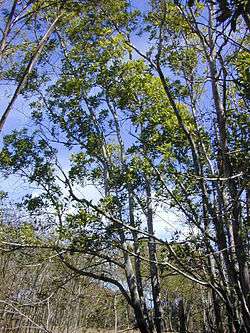Acacia mangium
| Acacia mangium | |
|---|---|
 | |
| Scientific classification | |
| Kingdom: | Plantae |
| (unranked): | Angiosperms |
| (unranked): | Eudicots |
| (unranked): | Rosids |
| Order: | Fabales |
| Family: | Fabaceae |
| Genus: | Acacia |
| Species: | A. mangium |
| Binomial name | |
| Acacia mangium Willd. | |
 | |
| Range of Acacia mangium | |
| Synonyms | |
Acacia mangium is a species of flowering tree in the pea family, Fabaceae, that is native to northeastern Queensland in Australia, the Western Province of Papua New Guinea, Papua, and the eastern Maluku Islands.[2] Common names include Black Wattle, Hickory Wattle, Mangium, and Forest Mangrove. Its uses include environmental management and wood.[1]
Cultivation
Acacia mangium grows up to 30 metres (98 ft), often with a straight trunk. A. mangium has about 142,000 seeds/kg.[3] To break down dormancy mature seed requires pre-germination treatments such as mechanical scarification (scratching the surface) or boiling water. This treatment leads to a fast germination and typically exceeds 75%.[4] Like many other legumes, it is able to fix nitrogen in the soil.[5] A. mangium is a popular species for forest plantation and used more and more also for agroforestry projects. In mixed cultures, plants can profit of the shadow from A. mangium and the nitrogen fixation[6] A. mangium will tolerate low fertility soils with impeded drainage, but prefers fertile sites with good drainage. Soil depth and topographic position can influence yields. With respect to distance from the equator, there are significant differences in performance under cultivation. A mean annual height increase of about 3 to 4 m is usual near the equator. In areas further from the equator growth is lower.[4]
Use
Timber
A. mangium trees produce sapwood and heartwood. The heartwood's colour is brownish yellow shimmery and medium textured. Because the timber is extremely heavy, hard, very strong, tough, and not liable to warp and crack badly it is used for furniture, doors and window frames. The glossy and smooth surface finish after polishing leads also to a potential for making export orientated parquet flooring tiles and artifacts.[7]
Industrial use
Since these trees crack easily and temperamental for use in furniture, this is mainly used for the paper pulp and biomass Fuel industries. Both industries will require the A. mangium trees to be chipped and delivered by the ton and moisture rates.
Soil management and ecological restoration
Because Acacia mangium trees largely increase the turnover rate of N in the topsoil, it might improve also the mineral N availability in soils in mixed cultures.[8] Due to the fact that it is a very fast growing tree it develops an intensive rooting system, particularly in a low fertility soil.[9] That helps to recover degraded tropical lands for what A. mangium is very useful.[8] The tree is widely used in Goa in the mining industry for rehabilitation of the waste dumps as it is a drought resistant species and binds the sterile mine waste consisting of lateritic strata.[10] In Columbia, it has been used for restoring wasteland created by open-pit gold mining.[11]
Chemistry
The gum contains 5.4% ash, 0.98% N, 1.49% methoxyl, and by calculation, 32.2% uronic acid.[12] The sugar composition after hydrolysis: 9.0% 4-0-methylglucuronic acid, 23.2% glucuronic acid, 56% galactose, 10% arabinose, and 2% rhamnose.
Gallery
-

Acacia mangium Cultivation in Africa
-

Trunk in Kolkata, West Bengal, India.
-

Tree in Kolkata, West Bengal, India.
-

Leaves with fruit pod at canopy in Kolkata, West Bengal, India.
-

Leaves at canopy on the branchesin Kolkata, West Bengal, India.
-

Leaves at canopy in Kolkata, West Bengal, India.
-

Acacia mangium Branch and Pods
-

Acacia mangium Old Bark
References
- 1 2 "Acacia mangium – ILDIS LegumeWeb". www.ildis.org. Archived from the original on 6 April 2008. Retrieved 2008-04-26.
- ↑ Francis, John K. (1 January 2003). "Acacia mangium Willd" (PDF). Tropical Tree Seed Manual. Reforestation, Nurseries & Genetics Resources. Archived from the original (PDF) on 16 January 2009. Retrieved 2009-02-24.
- ↑ "Growing Process of Tropical Trees-(Compiled version)". ftbc.job.affrc.go.jp. Archived from the original on 12 April 2008. Retrieved 2008-04-26.
- 1 2 Discover Life/ Royal Botanical Gardens
- ↑ "Acacia mangium". www.hort.purdue.edu. Archived from the original on 11 May 2008. Retrieved 2008-04-26.
- ↑ Jeyanny, V., SS Lee & K Wan Rasidah, Forest Research Institute Malaysia (2011). Effects of arbuscular mycorrhizal inoculation and fertilisation on the growth of Acacia mangium seedlings. Journal of Tropical Forest Science 23(4): 404–409
- ↑ Sharma, S. K., Kumar, P., Rao, R. V., Sujatha, M., Shukla, S. R., 2011. Rational utilization of plantation grown Acacia mangium Willd. Journal of the Indian Academy of Wood Science, 8(2):97–99
- 1 2 ^Voigtlaender M. et al. (2012). Introducing Acacia mangium trees in Eucalyptus grandis plantations: consequences for soil organic matter stocks and nitrogen mineralization. Plant and Soil 352(1–2):99–111 doi:10.1038/511155d
- ↑ Kadir W.R, Kadir A.A., Van Cleemput O., Zaharah Abdul Rahman. 1996. Field grown Acacia mangium: How intensive is root growth? Journal of Tropical Forest Science 10(3): 283–291 (1998)
- ↑ "Growing Process of Tropical Trees-(Compiled version)". ftbc.job.affrc.go.jp. Archived from the original on 12 April 2008. Retrieved 2008-04-26.
- ↑ Thomas, Evert (2014). "Gold rush: Forest devastated by mining is reborn". Nature. 511 (7508): 155–155. doi:10.1038/511155d.
- ↑ Anderson, D.M.W. (1978). "Chemotaxonomic aspects of the chemistry of acacia gum exudates.". Kew Bull. 32 (3): 529–536. doi:10.2307/4109654. JSTOR 4109654.
| Wikimedia Commons has media related to Acacia mangium. |
| Wikispecies has information related to: Acacia mangium |